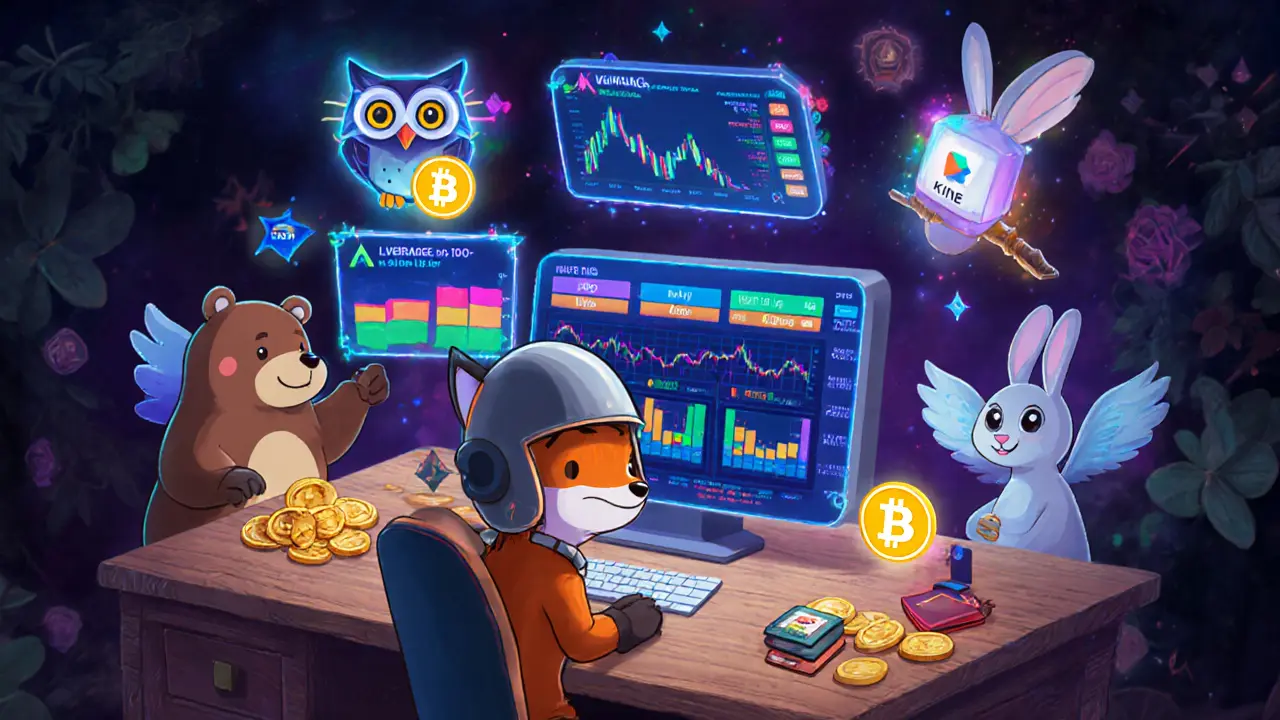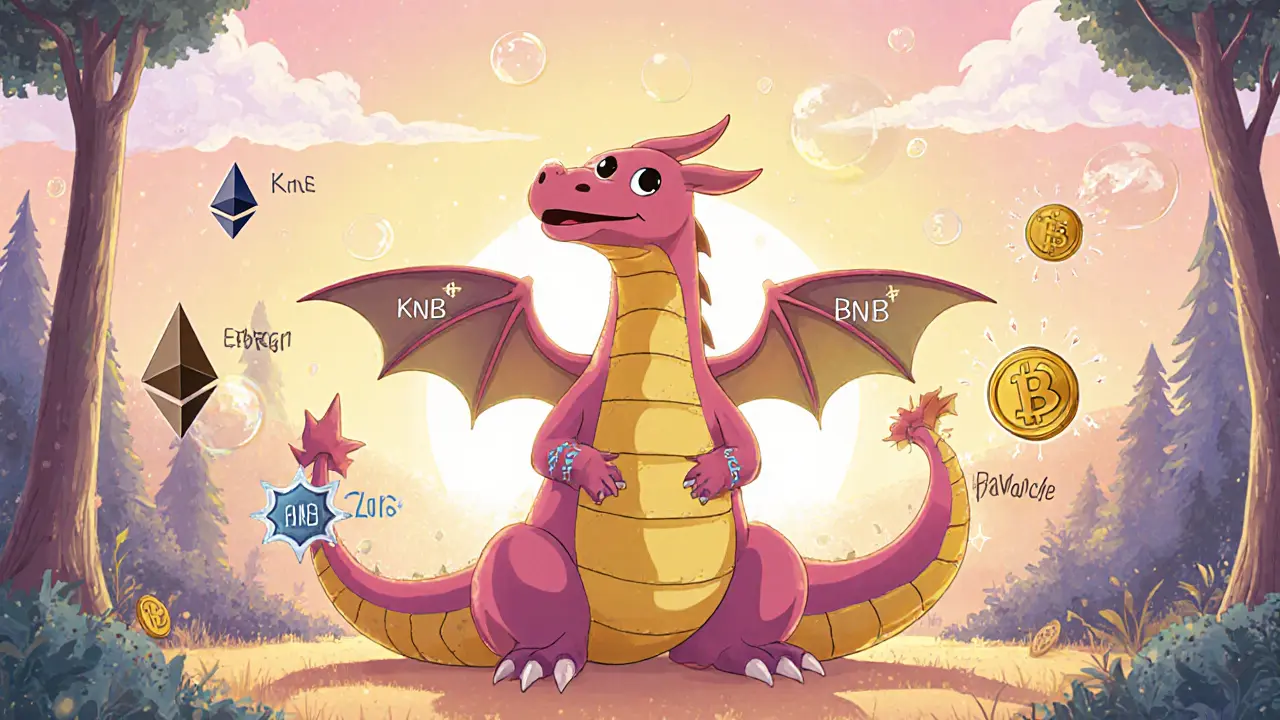KINE Token Price Tracker
Current KINE Token Price
$0.001324 +1.2%
As of October 2, 2025
Market Overview
24h Volume:
$2.8M
RSI (14-day):
29 (Oversold)
Fear & Greed Index:
33 (Fear)
30-day Green Days:
47%
Price Forecast
Conservative Estimate: $0.001364 (+3%)
Aggressive Estimate: $3.58 (256,924%)
Note: Aggressive forecast is highly speculative and not guaranteed.
Quick Stats
Token Utility
- Staking Rewards Active
- Governance Voting Active
- Fee Discounts Active
About KINE Token
KINE is the native utility token of Kine Protocol, used for:
- Staking collateral for derivatives positions
- Governance voting on protocol upgrades
- Earning fee discounts for stakers
When you hear the term Kine Protocol, think of a decentralized venue that lets you trade crypto derivatives without paying gas or dealing with slippage. Launched as a peer‑to‑pool system, the platform runs on multiple chains - Ethereum, BNB Chain, Polygon and Avalanche - and promises professional‑grade tools for traders who want more than a simple spot market.
TL;DR
- Kine Protocol is a cross‑chain, decentralized derivatives exchange with zero gas fees.
- Supports Ethereum, BNB Chain, Polygon, Avalanche; integrates with MetaMask, Bitget Wallet, MathWallet.
- Offers copy‑trading, staking, farming, but no spot trading yet.
- KINE token trades around $0.0013 (Oct2025) and is heavily oversold (RSI≈29).
- Best for experienced traders seeking high leverage; less ideal for beginners or spot‑only investors.
What Is Kine Protocol?
Kine Protocol is a decentralized cryptocurrency exchange that focuses exclusively on derivatives trading. It operates on a peer‑to‑pool model, meaning trades are matched against over‑collateralized liquidity pools rather than a traditional order book. This design eliminates gas fees and reduces slippage, two pain points that plague many DEXs.
Core Architecture and How It Works
The platform’s on‑chain execution engine processes every trade directly on the blockchain, pulling real‑time price feeds from trusted oracles. Because liquidity pools are over‑collateralized, the system guarantees execution even during volatile market swings. Users connect a compatible wallet - most commonly MetaMask, Bitget Wallet or MathWallet - and can start trading without any KYC hurdle.
Supported Blockchains and Token Ecosystem
Kine Protocol runs on four major networks:
- Ethereum (ERC‑20 tokens)
- BNB Chain (BEP‑20 tokens)
- Polygon (Polygon‑compatible ERC‑20)
- Avalanche (AVAX‑C‑Chain assets)
The native utility token is KINE. It powers fee discounts, staking rewards and governance voting. As of 2Oct2025, KINE trades at $0.001324, sits below its 50‑day and 200‑day SMAs, and shows an RSI of 29, indicating a heavily oversold market.
Key Features for Traders
- Zero gas fee trading - all swaps settle on‑chain without the user paying transaction costs.
- High leverage options (up to 100× on certain contracts).
- Professional‑grade UI with order types, charting tools, and real‑time P&L.
- Copy‑trading module that mirrors top performers.
- Staking and farming pools that generate passive yields on KINE.
What the platform lacks is spot trading. The roadmap mentions a spot module “on the horizon,” but no concrete launch date has been shared.
How Kine Stands Against the Competition
| Feature | Kine Protocol | Raydium (Solana) | Uniswap (Ethereum) | PancakeSwap (BNB Chain) |
|---|---|---|---|---|
| Derivatives Trading | Yes (native) | No (focus on spot) | No (spot only) | No (spot only) |
| Zero Gas Fees | Yes (peer‑to‑pool) | No (solana fees low but not zero) | No (Ethereum gas) | No (BNB Chain fees) |
| Leverage Options | Up to 100× | None | None | None |
| Copy‑Trading | Built‑in | Third‑party only | No | No |
| KYC Required | No | No | No | No |
| Supported Chains | 4 (ETH, BNB, Polygon, AVAX) | Solana | Ethereum | BNB Chain |
The table highlights why Kine is the go‑to DEX for derivatives‑centric traders. Its zero‑gas model and high leverage are hard to match on the other platforms, which focus primarily on spot liquidity.

Security and Safety Considerations
Security audits for Kine Protocol are cited in community posts but full audit reports are not publicly hosted. The platform mitigates risk through over‑collateralized pools and on‑chain execution, which reduces counter‑party exposure. Still, the absence of a transparent audit trail means you should treat large positions with caution and consider diversifying across other audited DEXs.
User Experience: Onboarding and Daily Use
- Install a supported wallet (MetaMask, Bitget Wallet, or MathWallet).
- Visit the Kine Protocol web app and click “Connect Wallet”.
- Choose your network (Ethereum, BNB Chain, Polygon, or Avalanche).
- Deposit KINE or any supported collateral token into the liquidity pool.
- Navigate to the derivatives tab, select contract type (perpetual, futures), set leverage, and place your order.
The UI mirrors familiar centralized exchange layouts, making the transition smoother for traders coming from Binance or Kraken. Mobile apps for iOS and Android mirror the web experience, which is a plus for on‑the‑go users.
KINE Token Economics & Market Outlook
The KINE token serves three core purposes:
- Staking collateral for derivatives positions.
- Governance voting on protocol upgrades.
- Fee discounts for stakers.
Current market data (Oct2025):
- Price: $0.001324
- 24‑hour volume: $2.8M
- Fear & Greed Index: 33 (Fear)
- RSI: 29 (oversold)
- 30‑day green days: 47%
Analyst forecasts diverge wildly. Conservative estimates (CoinCodex) predict a modest rise to $0.001364 by year‑end, implying a 3% upside. Aggressive models (CoinLore) envision a meteoric climb to $3.58, a 256,924% jump - clearly speculative given current liquidity and market sentiment. Realistic investors should base expectations on the more restrained range while keeping an eye on upcoming spot‑trade rollout, which could broaden the token’s utility and boost demand.
Pros and Cons - Quick Reference
- Pros:
- Zero gas fees reduce cost of frequent trading.
- High leverage for sophisticated strategies.
- Copy‑trading lowers barrier for newcomers.
- Cross‑chain support expands asset choices.
- No KYC - privacy preserved.
- Cons:
- No spot trading limits overall market appeal.
- Limited token list - only a few major assets.
- Audit reports not publicly disclosed.
- UI can be intimidating for absolute beginners.
Who Should Use Kine Protocol?
If you’re a trader who already uses futures or perpetual contracts on centralized platforms, Kine offers a decentralized alternative with zero‑gas execution and professional charting tools. The copy‑trading feature also helps less‑experienced users mirror proven strategies, provided they keep leverage modest. Conversely, investors looking for a one‑stop spot‑and‑derivatives solution should probably wait for the upcoming spot module or consider a more all‑round DEX like Uniswap.
Future Roadmap and Outlook
Development updates indicate three near‑term goals:
- Launch of a dedicated spot‑trading module (expected Q22026).
- Integration of a deeper oracle network to tighten price feeds.
- Publication of a formal third‑party security audit.
Successfully delivering these milestones could shift Kine from a niche derivatives DEX to a broader DeFi hub, potentially lifting KINE’s utility and market cap.
Frequently Asked Questions
Is Kine Protocol truly a zero‑gas exchange?
Yes. Kine’s peer‑to‑pool model absorbs transaction costs within the liquidity pool, meaning traders pay no separate gas fees for each swap. The cost is effectively covered by the pool’s over‑collateralization.
Can I trade on Kine without completing KYC?
Exactly. Kine operates fully on‑chain, so there’s no KYC checkpoint. All you need is a compatible wallet.
What leverage levels are available?
Leverage varies by asset but can reach up to 100× on high‑liquidity contracts. Lower‑liquidity pairs may cap at 25× to manage risk.
How do I start copy‑trading?
After connecting your wallet, go to the “Copy‑Trading” tab, browse the leader board, and click “Follow”. Your account will automatically replicate the chosen trader’s positions in real time.
Is the KINE token required for trading?
You can use KINE as collateral for leverage and to earn fee discounts, but you can also post other supported assets (ETH, BNB, USDT, etc.) as collateral.

